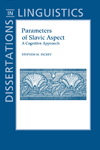Stephen M. Dickey
Parameters of Slavic Aspect: A Cognitive Approach presents the first detailed comparative analysis of verbal aspect in the Slavic languages. Dickey divides the Slavic languages into two aspectual groups, an eastern and a western group as well as a transitional zone between the two. This book shows the semantic meaning of aspect in these groups, analyzed within the framework of cognitive grammar. Dickey offers the first comparative analysis of Slavic aspect treating more than two languages, and the first book-length cognitive linguistic analysis of Slavic aspect.
Dickey establishes seven parameters of variation in aspectual usage: habituality, the simple denotation of past actions, the historical present, stage directions and other instructions, performatives and other cases of the coincidence of utterance and action, the imperfective in sequences of actions, and the derivation of verbal nouns. These parameters are used as a basis for dividing the Slavic languages into the western group of Czech, Slovak, Slovene, Sorbian, the eastern group of Russian, Ukrainian, Belarusian, Bulgarian and the transitional zone of Serbo-Croatian and Polish. Dickey uses concepts from cognitive grammar to construct a semantic analysis of the category of aspect in each group and in the transitional zone. Ultimately, Dickey shows that western aspect centers around the category of totality, whereas eastern aspect centers around a category of temporal definiteness.
Stephen M. Dickey was in the Department of Slavic Languages and Literature at the University of Virginia at the time of this publication.
- Preface
- Chapter 1 Preliminaries
- 1.0 Introduction
- 1.1 The Nature of Slavic Verbal Aspect
- 1.1.1 Morphology
- 1.1.2 Basic Semantic Issues
- 1.2 Semantic Definitions of Slavic Aspect
- 1.3 Theoretical Preliminaries
- 1.3.1 Cognitive Grammar
- 1.3.2 Cognitive Grammar and Aspect
- 1.4 The Interrelation between Aspect and Situation Type
- 1.5 Aspectual Pairs
- 1.6 Conclusion
- Chapter 2: Habitual Expressions
- 2.0 Introduction
- 2.1 The Aspectual Nature of Habituals
- 2.2 Habituals in the Present Tense
- 2.2.1 Data and Basic Analysis
- 2.2.2 The Transitional Status of Pol and SC
- 2.3 Habituals in the Past Tense
- 2.4 Further Discussion
- 2.5 Conclusion
- Chapter 3: The Imperfective General-Factual
- 3.0 Introduction
- 3.1 The Nature of the Imperfective General-Factual
- 3.2 Data and Basic Analysis
- 3.3 Reversed Action
- 3.4 Accomplishments Reexamined; Repetitives
- 3.5 Further Discussions: Eastern Aspect and Definiteness
- 3.6 Conclusion
- Chapter 4: The Historical Present
- 4.0 Introduction
- 4.1 The Temporal and Aspectual Nature of the Historical Present
- 4.2 Data and Basic Analysis
- 4.3 The Transitional Zones: Pol and SC
- 4.4 Further Discussion
- 4.5 Conclusion
- Chapter 5: Running Instructions and Running Commentaries
- 5.0 Introduction
- 5.1 The Temporal Qualities of Running Instructions and Commentaries
- 5.2 Data and Basic Analysis
- 5.3 Further Discussion
- 5.4 Conclusion
- Chapter 6: Coincidence
- 6.0 Introduction
- 6.1 Performative and the Temporal Aspectual Qualities of Coincidence
- 6.2 Data and Basic Analysis
- 6.3 Non-Performative Verbs and Further Discussions
- 6.4 Exceptional Cases of Coincidences in South Slavic
- 6.5 Conclusion
- Chapter 7: The Imperfective Sequence of Events and Other Expressions of Ingressivity
- 7.0 Introduction
- 7.1 The Czech Contextually-Conditioned Imperfective
- 7.2 Data and Basic Analysis
- 7.3 Comparable Expressions of Ingressivity in the East: Phasal stat′ and Ingressive Aktionsart Verbs in za-
- 7.3.1 Stat′ as an Ingressive Verb in Slavic
- 7.3.2 The Ingressive Aktionsart: Slavic za-
- 7.4 Further Discussion
- 7.5 Conclusion
- Chapter 8: Verbal Nouns
- 8.0 Introduction
- 8.1 Nouns and Verbs
- 8.2 Data
- 8.2.1 Czech, Slovak and Polish
- 8.2.2 Slovene
- 8.2.3 Serbo-Croation
- 8.2.4 Bulgarian
- 8.2.5 Russian
- 8.2.6 Ukraine
- 4.3 Basic Anlysis
- 4.4 Further Discussion
- 4.5 Conclusion
- Chapter 9: Concluding Remarks
- 9.0 Introduction
- 9.1 The East-West Isogloss
- 9.2 Theoretical Issues
- 9.3 Remarks on Diachrony
- 9.4 Conclusion
- Refereneced
- Index
4/1/2000


